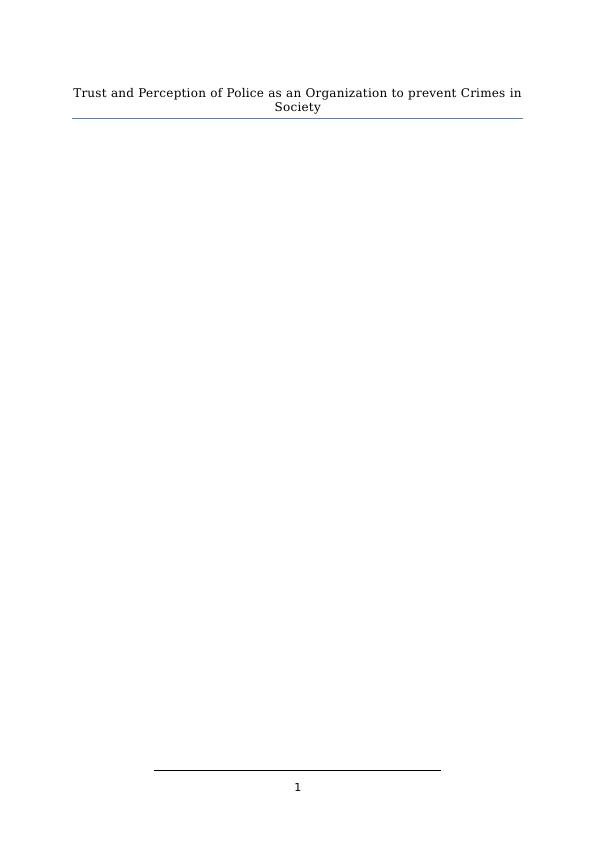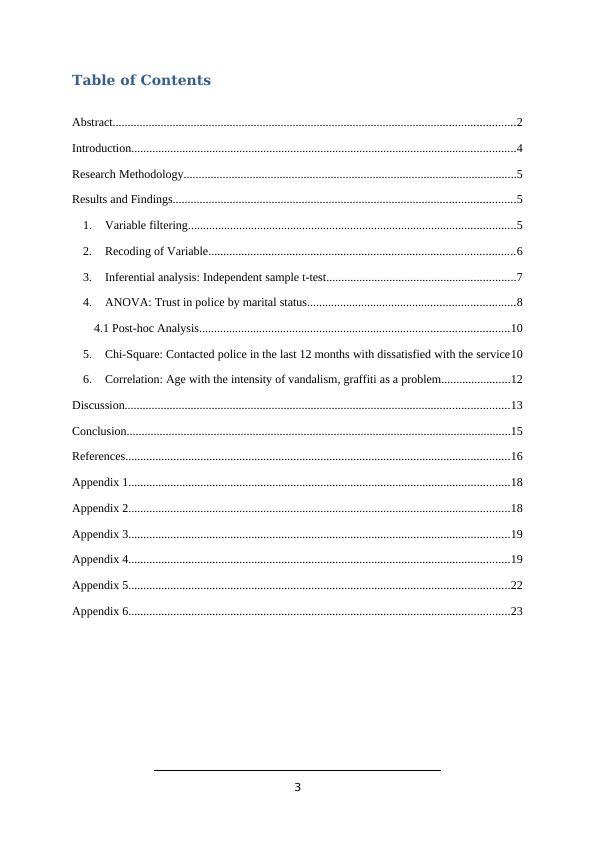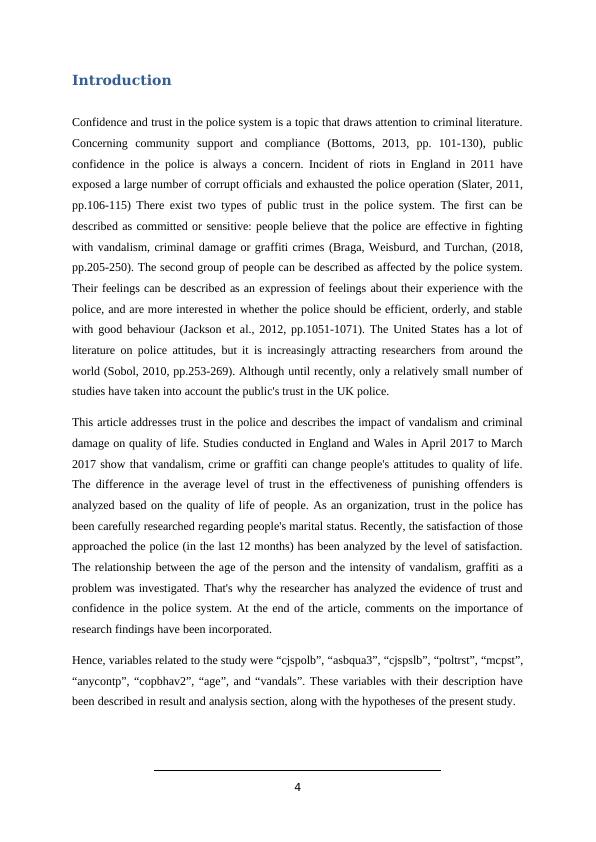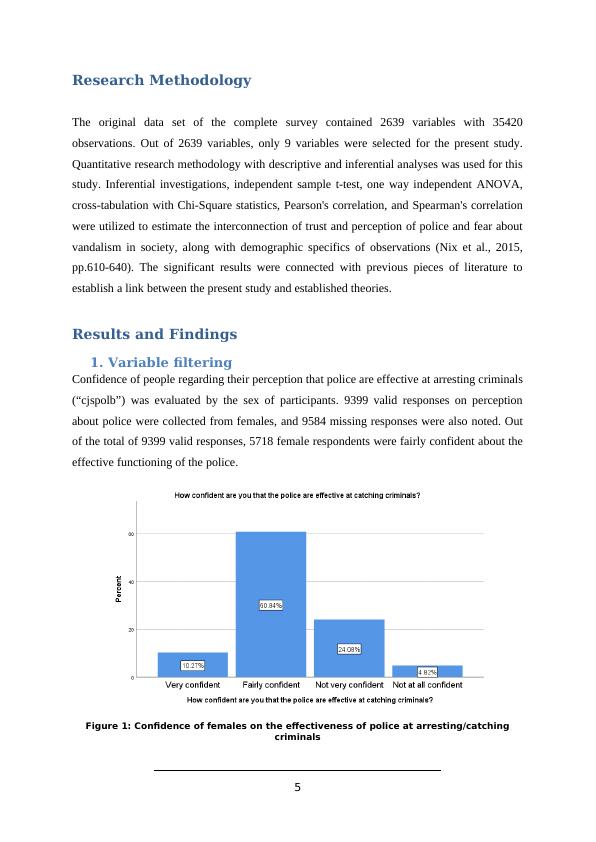Trust and Perception of Police as an Organization to prevent
Added on 2022-11-18
25 Pages4697 Words1 Views
Trust and Perception of Police as an Organization to prevent Crimes in
Society
1
Society
1

Abstract
Quantitative measures were used to analyse the relation between fear of crime and perception
of efficiency of the police system. Trusts on the police system and age relation with fear of
vandalism were the two important factors of study. Inferential analyses used in this work are
t-test, one way independent ANOVA, cross tabulation, and correlation. The study found that
confidence in police in dealing with criminals was not related on how vandalism or criminal
damage affects the quality of life. A significant difference was noted between the average
trust in the police of an unmarried/ single person and a married person. Relationship between
police complaints and dissatisfaction with the services provided by the police over the past 12
months was statistically significant. Respondent's age and perception about the intensity of
violence had a statistically significant relation.
2
Quantitative measures were used to analyse the relation between fear of crime and perception
of efficiency of the police system. Trusts on the police system and age relation with fear of
vandalism were the two important factors of study. Inferential analyses used in this work are
t-test, one way independent ANOVA, cross tabulation, and correlation. The study found that
confidence in police in dealing with criminals was not related on how vandalism or criminal
damage affects the quality of life. A significant difference was noted between the average
trust in the police of an unmarried/ single person and a married person. Relationship between
police complaints and dissatisfaction with the services provided by the police over the past 12
months was statistically significant. Respondent's age and perception about the intensity of
violence had a statistically significant relation.
2

Table of Contents
Abstract......................................................................................................................................2
Introduction................................................................................................................................4
Research Methodology...............................................................................................................5
Results and Findings..................................................................................................................5
1. Variable filtering.............................................................................................................5
2. Recoding of Variable......................................................................................................6
3. Inferential analysis: Independent sample t-test...............................................................7
4. ANOVA: Trust in police by marital status.....................................................................8
4.1 Post-hoc Analysis.......................................................................................................10
5. Chi-Square: Contacted police in the last 12 months with dissatisfied with the service10
6. Correlation: Age with the intensity of vandalism, graffiti as a problem.......................12
Discussion................................................................................................................................13
Conclusion................................................................................................................................15
References................................................................................................................................16
Appendix 1...............................................................................................................................18
Appendix 2...............................................................................................................................18
Appendix 3...............................................................................................................................19
Appendix 4...............................................................................................................................19
Appendix 5...............................................................................................................................22
Appendix 6...............................................................................................................................23
3
Abstract......................................................................................................................................2
Introduction................................................................................................................................4
Research Methodology...............................................................................................................5
Results and Findings..................................................................................................................5
1. Variable filtering.............................................................................................................5
2. Recoding of Variable......................................................................................................6
3. Inferential analysis: Independent sample t-test...............................................................7
4. ANOVA: Trust in police by marital status.....................................................................8
4.1 Post-hoc Analysis.......................................................................................................10
5. Chi-Square: Contacted police in the last 12 months with dissatisfied with the service10
6. Correlation: Age with the intensity of vandalism, graffiti as a problem.......................12
Discussion................................................................................................................................13
Conclusion................................................................................................................................15
References................................................................................................................................16
Appendix 1...............................................................................................................................18
Appendix 2...............................................................................................................................18
Appendix 3...............................................................................................................................19
Appendix 4...............................................................................................................................19
Appendix 5...............................................................................................................................22
Appendix 6...............................................................................................................................23
3

Introduction
Confidence and trust in the police system is a topic that draws attention to criminal literature.
Concerning community support and compliance (Bottoms, 2013, pp. 101-130), public
confidence in the police is always a concern. Incident of riots in England in 2011 have
exposed a large number of corrupt officials and exhausted the police operation (Slater, 2011,
pp.106-115) There exist two types of public trust in the police system. The first can be
described as committed or sensitive: people believe that the police are effective in fighting
with vandalism, criminal damage or graffiti crimes (Braga, Weisburd, and Turchan, (2018,
pp.205-250). The second group of people can be described as affected by the police system.
Their feelings can be described as an expression of feelings about their experience with the
police, and are more interested in whether the police should be efficient, orderly, and stable
with good behaviour (Jackson et al., 2012, pp.1051-1071). The United States has a lot of
literature on police attitudes, but it is increasingly attracting researchers from around the
world (Sobol, 2010, pp.253-269). Although until recently, only a relatively small number of
studies have taken into account the public's trust in the UK police.
This article addresses trust in the police and describes the impact of vandalism and criminal
damage on quality of life. Studies conducted in England and Wales in April 2017 to March
2017 show that vandalism, crime or graffiti can change people's attitudes to quality of life.
The difference in the average level of trust in the effectiveness of punishing offenders is
analyzed based on the quality of life of people. As an organization, trust in the police has
been carefully researched regarding people's marital status. Recently, the satisfaction of those
approached the police (in the last 12 months) has been analyzed by the level of satisfaction.
The relationship between the age of the person and the intensity of vandalism, graffiti as a
problem was investigated. That's why the researcher has analyzed the evidence of trust and
confidence in the police system. At the end of the article, comments on the importance of
research findings have been incorporated.
Hence, variables related to the study were “cjspolb”, “asbqua3”, “cjspslb”, “poltrst”, “mcpst”,
“anycontp”, “copbhav2”, “age”, and “vandals”. These variables with their description have
been described in result and analysis section, along with the hypotheses of the present study.
4
Confidence and trust in the police system is a topic that draws attention to criminal literature.
Concerning community support and compliance (Bottoms, 2013, pp. 101-130), public
confidence in the police is always a concern. Incident of riots in England in 2011 have
exposed a large number of corrupt officials and exhausted the police operation (Slater, 2011,
pp.106-115) There exist two types of public trust in the police system. The first can be
described as committed or sensitive: people believe that the police are effective in fighting
with vandalism, criminal damage or graffiti crimes (Braga, Weisburd, and Turchan, (2018,
pp.205-250). The second group of people can be described as affected by the police system.
Their feelings can be described as an expression of feelings about their experience with the
police, and are more interested in whether the police should be efficient, orderly, and stable
with good behaviour (Jackson et al., 2012, pp.1051-1071). The United States has a lot of
literature on police attitudes, but it is increasingly attracting researchers from around the
world (Sobol, 2010, pp.253-269). Although until recently, only a relatively small number of
studies have taken into account the public's trust in the UK police.
This article addresses trust in the police and describes the impact of vandalism and criminal
damage on quality of life. Studies conducted in England and Wales in April 2017 to March
2017 show that vandalism, crime or graffiti can change people's attitudes to quality of life.
The difference in the average level of trust in the effectiveness of punishing offenders is
analyzed based on the quality of life of people. As an organization, trust in the police has
been carefully researched regarding people's marital status. Recently, the satisfaction of those
approached the police (in the last 12 months) has been analyzed by the level of satisfaction.
The relationship between the age of the person and the intensity of vandalism, graffiti as a
problem was investigated. That's why the researcher has analyzed the evidence of trust and
confidence in the police system. At the end of the article, comments on the importance of
research findings have been incorporated.
Hence, variables related to the study were “cjspolb”, “asbqua3”, “cjspslb”, “poltrst”, “mcpst”,
“anycontp”, “copbhav2”, “age”, and “vandals”. These variables with their description have
been described in result and analysis section, along with the hypotheses of the present study.
4

Research Methodology
The original data set of the complete survey contained 2639 variables with 35420
observations. Out of 2639 variables, only 9 variables were selected for the present study.
Quantitative research methodology with descriptive and inferential analyses was used for this
study. Inferential investigations, independent sample t-test, one way independent ANOVA,
cross-tabulation with Chi-Square statistics, Pearson's correlation, and Spearman's correlation
were utilized to estimate the interconnection of trust and perception of police and fear about
vandalism in society, along with demographic specifics of observations (Nix et al., 2015,
pp.610-640). The significant results were connected with previous pieces of literature to
establish a link between the present study and established theories.
Results and Findings
1. Variable filtering
Confidence of people regarding their perception that police are effective at arresting criminals
(“cjspolb”) was evaluated by the sex of participants. 9399 valid responses on perception
about police were collected from females, and 9584 missing responses were also noted. Out
of the total of 9399 valid responses, 5718 female respondents were fairly confident about the
effective functioning of the police.
Figure 1: Confidence of females on the effectiveness of police at arresting/catching
criminals
5
The original data set of the complete survey contained 2639 variables with 35420
observations. Out of 2639 variables, only 9 variables were selected for the present study.
Quantitative research methodology with descriptive and inferential analyses was used for this
study. Inferential investigations, independent sample t-test, one way independent ANOVA,
cross-tabulation with Chi-Square statistics, Pearson's correlation, and Spearman's correlation
were utilized to estimate the interconnection of trust and perception of police and fear about
vandalism in society, along with demographic specifics of observations (Nix et al., 2015,
pp.610-640). The significant results were connected with previous pieces of literature to
establish a link between the present study and established theories.
Results and Findings
1. Variable filtering
Confidence of people regarding their perception that police are effective at arresting criminals
(“cjspolb”) was evaluated by the sex of participants. 9399 valid responses on perception
about police were collected from females, and 9584 missing responses were also noted. Out
of the total of 9399 valid responses, 5718 female respondents were fairly confident about the
effective functioning of the police.
Figure 1: Confidence of females on the effectiveness of police at arresting/catching
criminals
5

2263 female respondents lacked confidence in the police would arresting criminals, whereas,
453 females were not at all confident in the police system. One respondent refused to answer,
and 418 were not sure about their opinions. 9165 system missing observations were identified
among 9584 missing observations. Figure 1 reveals the detailed distribution of responses of
females regarding their perception of police arresting criminals.
2. Recoding of Variable
Effect of vandalism, criminal damage, and graffiti on quality of life ("asbqua3") were re-
coded from continuous to a categorical variable. Among the total observation of 35420, mere
967 valid observations were identified. The scale of response for "asbqua3" varied from 1 to
10, where 1 implied that quality of life was least affected by vandalism, criminal damage, and
graffiti and 10 was the highest response value indicating the worst impact of vandalism,
criminal damage, and graffiti on quality of life. The variable was recoded to a new
categorical variable with two categories ("Not much" and "Very Much"). Out of 967 valid
responses, 771 responses were re-categorized in "Not Much", and 196 valid responses were
categorized as "Very Much". Figure 2 reveals that there was a slight to moderate adverse
impact of vandalism, criminal damage, and graffiti on quality of life in the case of the
majority of the valid respondents. The new categorical variable was named as “asbqua_cat”.
Figure 2: Categorical segregation of the effect of vandalism, criminal damage, and
graffiti on quality of life
6
453 females were not at all confident in the police system. One respondent refused to answer,
and 418 were not sure about their opinions. 9165 system missing observations were identified
among 9584 missing observations. Figure 1 reveals the detailed distribution of responses of
females regarding their perception of police arresting criminals.
2. Recoding of Variable
Effect of vandalism, criminal damage, and graffiti on quality of life ("asbqua3") were re-
coded from continuous to a categorical variable. Among the total observation of 35420, mere
967 valid observations were identified. The scale of response for "asbqua3" varied from 1 to
10, where 1 implied that quality of life was least affected by vandalism, criminal damage, and
graffiti and 10 was the highest response value indicating the worst impact of vandalism,
criminal damage, and graffiti on quality of life. The variable was recoded to a new
categorical variable with two categories ("Not much" and "Very Much"). Out of 967 valid
responses, 771 responses were re-categorized in "Not Much", and 196 valid responses were
categorized as "Very Much". Figure 2 reveals that there was a slight to moderate adverse
impact of vandalism, criminal damage, and graffiti on quality of life in the case of the
majority of the valid respondents. The new categorical variable was named as “asbqua_cat”.
Figure 2: Categorical segregation of the effect of vandalism, criminal damage, and
graffiti on quality of life
6

End of preview
Want to access all the pages? Upload your documents or become a member.
Related Documents
Crime Rates Perception and their Effect on Gender and Agelg...
|26
|4848
|24
Trust and Perception of Police as an Organization to prevent Crimes in Society Case Study 2022lg...
|20
|1142
|25
SPSS Data Analysislg...
|17
|3874
|1
Prevalence of Local Crimes in England and Wales: A Statistical Analysislg...
|33
|7389
|448
